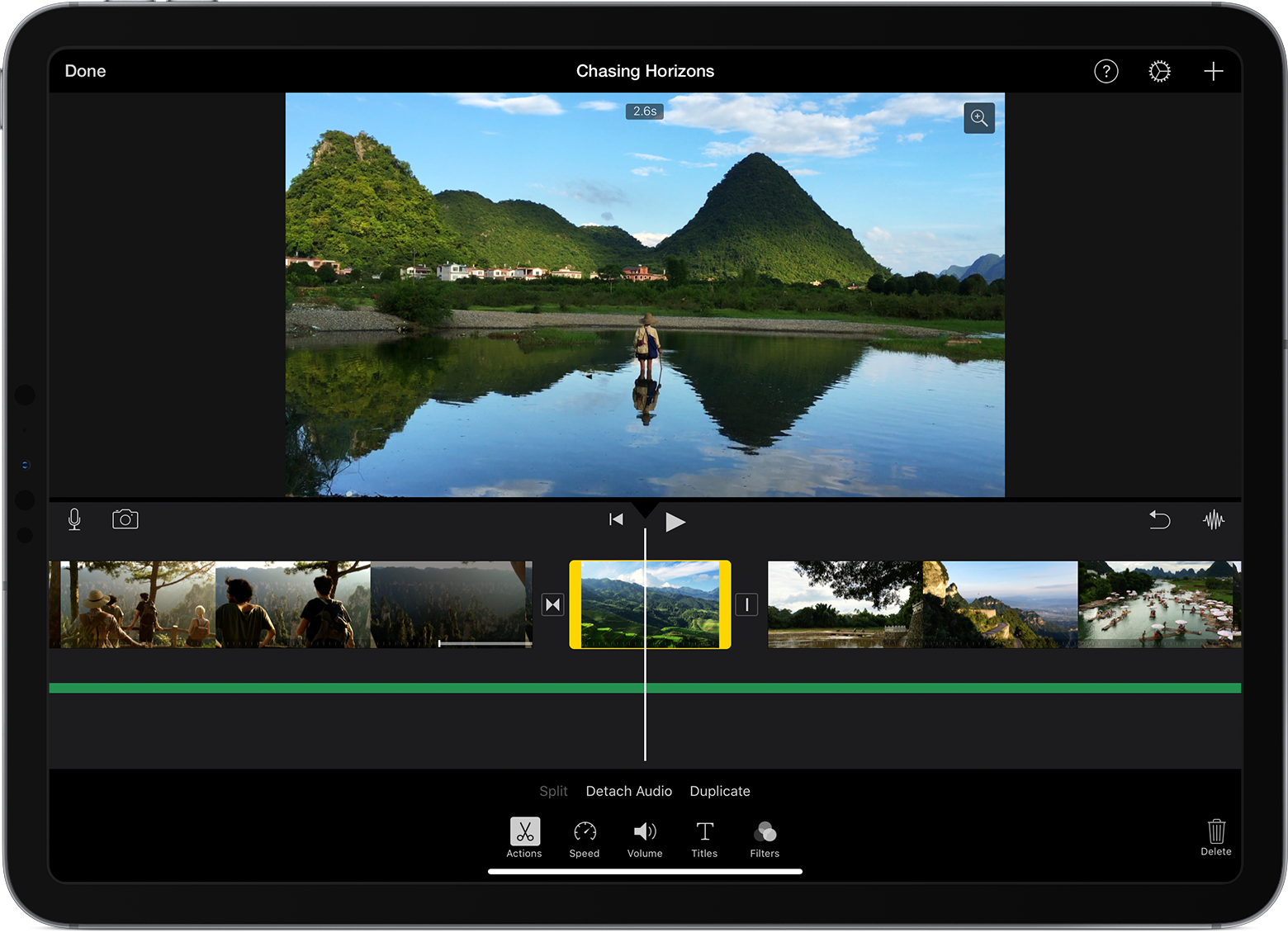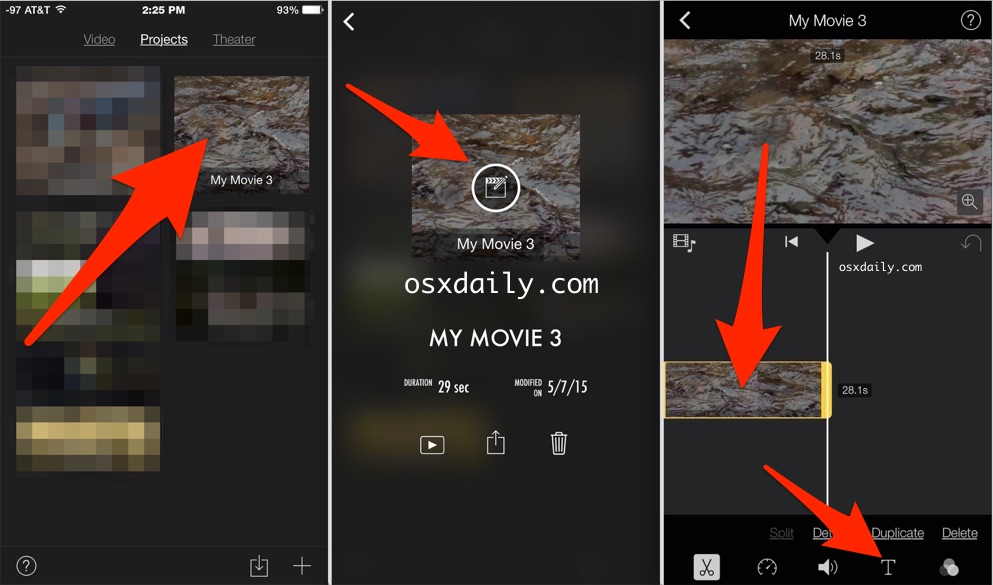How to make cinematic edits on Imovie in 2018. Do not waste money on fancy editing softwares when you can make banger edits on Imovie for Free! You have hundreds of videos. And one big dream to be a moviemaker. IMovie trailers let you quickly create fun, Hollywood-style movie trailers from all that footage. Choose from a range of templates in almost any genre, pick your studio logo, and type in your movie title and credits. Then add photos and videos to the storyboard. The Best Free iMovie Themes: Make your Video with Wondershare UniConverter Wondershare UniConverter is the perfect video editing program for any professional or novice video editor. It is simple to understand thanks to the clearly labeled buttons and menus. IMovie for MacOS can be daunting to the amateur iPhone ($900 at Boost Mobile) videographer. For a consumer-grade video editor, the MacOS app is fairly complex. Here are some tips and tricks to.
Sure, your iPhone can film incredible videos, but what do you do with them afterwards? How do you edit these videos a little more than just trimming them down or how do you string a couple of clips together to make one video? That's where iMovie comes in. Keep reading, and we'll go over some of the basics of you can do with this native editing app.
What can you do with iMovie's editing tools?

If you're at all familiar with iMovie on your Mac then the iOS version will probably feel very similar to you. But if this is your first time opening either version of iMovie, all the options and tools might seem overwhelming. Once you have a project opened and your clip(s) imported, you'll see buttons to:

If you're at all familiar with iMovie on your Mac then the iOS version will probably feel very similar to you. But if this is your first time opening either version of iMovie, all the options and tools might seem overwhelming. Once you have a project opened and your clip(s) imported, you'll see buttons to:
- Split a clip: cut a video into two separate clips.
- Trim a clip: shorten the length of your videos either starting them later or ending them earlier.
- Adjust the speed of a clip: make your clip go faster or slower.
- Add transitions: add a dissolve, wipe, or a simple fade in between video clips.
- Add titles: put fun text on your videos to help set up the video, like when or where it was filmed.
- Add a filter: add certain video filters that give your clips special effects or color them differently.
- Add music or sounds: add background music or audio to enhance your videos.
- Remove audio: detach the audio you don't want from the video and delete it.
Videos can take up a lot of storage, especially if you're keeping both edited and original clips. To free up some space, try an app like Gemini Photos. It will scan your videos, sort them by size, and help you delete or trim the larger videos you don't want anymore.
Download on the App StoreHow to use iMovie on iPhone to create a Movie
After you download iMovie from the App Store and open it for the first time, you'll get a prompt asking you to choose between working on a Movie or a Trailer. The latter is a fun feature that puts a few clips together into a Hollywood-style movie trailer. But because there's not much more you can do with that feature, we're going to focus the article on working on a Movie.
Step 1. Create a new project
When you open up iMovie on your phone, you should be taken to the Projects screen where you'll see a list of all of the projects you've created. To create a new project:
- Tap Create a Project > Movie.
- Select the clips you want to import.
- Tap Create Movie.
If you already have a project open in iMovie, then you'll need to tap Done > Projects, to get back to the Projects screen before you can follow the steps above.
Step 2. Edit the video(s) with iMovie
Once you have your videos imported into an iMovie project, it couldn't be easier to edit them. If you're looking for help performing a specific task, follow the guides below. They all assume you're already editing a project and have it open in iMovie.
How to split clips in iMovie
- Tap on any of the videos to bring up the editing tools.
- Slide the clip left or right, until the playhead is where you want the clip to be split.
- Tap Split.
How to crop videos in iMovie
- Tap on the clip you want to crop.
- Tap on the magnifying glass in the top right corner.
- Pinch to zoom in on your clip and to crop the selection of the video you want.
How to find and apply iMovie themes
- Make sure you don't have a clip selected. If you do, tap anywhere on your screen.
- Tap the gear in the bottom right corner to access the project settings.
- Select the Theme you want to use.
- Tap Done
How to get filters in iMovie
- Without any of the clips selected, tap on the gear icon in the bottom right corner.
- Select the filter you want to apply.
- Tap Done.
Step 3. Add effects and transitions in iMovie
As you start adding more videos into your project, you might want to get a little more creative. You can add effects to your videos, choose from transitions that fade or wipe across the screen, and even create a picture-in-picture effect with your clips.
How to add an effect in iMovie
- Tap on the clip you want to add the effect to.
- Tap on the three circles in the bottom right corner.
- Select the effect you want to apply.
How to add a transition
Transitions are automatically added in once you add another clip to your project. To change the type of transition:
- Tap on the transition.
- Select the animation you want it to do.
- Tap anywhere else on the screen to apply the new transition.
How to add a picture-in-picture effect in iMovie
- Tap the + icon.
- Select the video you want to add.
- Tap the ellipses > Picture in Picture.
Step 4. Download or share your iMovie video
After you're done making all your edits, downloading and sharing your new video is just as easy. With the project open in iMovie:
- Tap Done.
- Tap the Share button.
- Select to either Save Video or share it with one of your other apps.
Filming videos on your iPhone is simple and fun, especially with all the new capabilities in the 2019 iPhones. With iMovie, editing them is easy too. Just follow along with the step-by-step guides above, and you'll be editing videos on your phone like the best of them. And don't forget to share your latest creations with all of us online!
Record 4k or 60 fps video
You can set your iPhone or iPad to record 4k or 60 fps video. If you're recording video with a device not made by Apple, contact the company that makes the device for instructions on how to set your device to record 4k or 60 fps video.
For superior sharpness and quality, record and edit video recorded at 4K. For a smoother and more true-to-life look, try recording and editing video at 60 fps.
Use 4k or 60 fps video in iMovie
After you've recorded 4k or 60 fps video, simply add the video clips to your project in iMovie. You can combine 4k and 60 fps video clips with other types of video clips and photos in the same project.
Use 4k or 60 fps video on iPhone or iPad
In iMovie on iPhone or iPad, make sure your project has at least one 4k or 60 fps video clip.1 You can also share a 4k or 60 fps video if your project contains only photos.
Use 4k or 60 fps video on Mac
In iMovie on Mac, make sure the first clip you add to your project is a 4k or 60 fps video clip.2 The first clip you add to a project determines the format for the entire project.
To confirm your project's video format, click Settings in the upper right side of the timeline. The format of the current project appears under Project Settings in the window.
Share a 4k project from iMovie
You can share a 4k project from iMovie on iPhone, iPad, or Mac. iMovie shares 4K projects at a resolution of 3840 x 2160 in the 4K UHD format at 30 fps.
Share a 4k project on iPhone or iPad
- Select a movie or trailer in the Projects view.
- Tap the Share button .
- Tap Save Video.
- Choose 4K. iMovie exports your video to the Photo Library in the Photos app.
You can also share a 4K video directly from iMovie to YouTube. When sharing to other online destinations, your movie might be converted to a lower resolution.
Share 4k video on Mac
- Select a movie or trailer in the Projects view.
- Click the Share button .
- Click File.
- In the Share window, choose 4K from the Resolution pop-up menu.
- Set other options, click Next, then save your movie.
You can also share a 4K video directly from iMovie to YouTube. When sharing to other online destinations, your movie might be converted to a lower resolution.
Share 60 fps video from iMovie
You can share 60 fps video from iMovie on iPhone, iPad, or Mac. iMovie shares 60 fps projects at a resolution of 1920x1080 (also called 1080p60).
Sample Video Clips For Imovie Video Editor
Share a 60 fps project on iPhone or iPad
- Open the Settings app, tap iMovie, then select 'Enable 60 fps export.'
- Choose the movie or trailer in the Projects view that you want to share.
- Tap the Share button .
- Tap Save Video.
- Choose ' HD - 1080p60.' You can also choose resolutions lower than 1080p, while still preserving the 60 fps frame rate. iMovie exports your video to the Photo Library in the Photos app.
Hp officejet 5200 scan to pdf. You can also share a 60 fps video directly from iMovie to YouTube. When sharing to other online destinations, your movie might be converted to a lower resolution.
Share a 60 fps video on Mac
- Select a movie or trailer in the Projects view.
- Click the Share button .
- Click File.
- In the Share window, choose '1080p 60' from the Resolution pop-up menu. You can also choose resolutions lower than 1080p, while still preserving the 60 fps frame rate.
- Set other options, click Next, then save your movie.
You can also share a 60 fps video directly from iMovie to YouTube. When sharing to other online destinations, your movie might be converted to a lower resolution.
View a project in 4K while editing
With iMovie 10.1 or later on an iMac with Retina 5K display, you can view pixel-for-pixel 4K video while editing your movie. First, put iMovie into full screen mode—click the green button in the top-left corner of the iMovie window. Then drag the lower edge of the Viewer to expand it to its maximum size, which shows 4K video at 100% resolution.
1 For iMovie for iOS, you can edit and share 4K video on iPhone 6s, iPhone 6s Plus, iPad Air 2, iPad Pro, and later devices.
Trim Clip Imovie
2 For iMovie for macOS, you can edit and share 4K video on Mac computers from 2011 or later with at least 4GB of memory.

